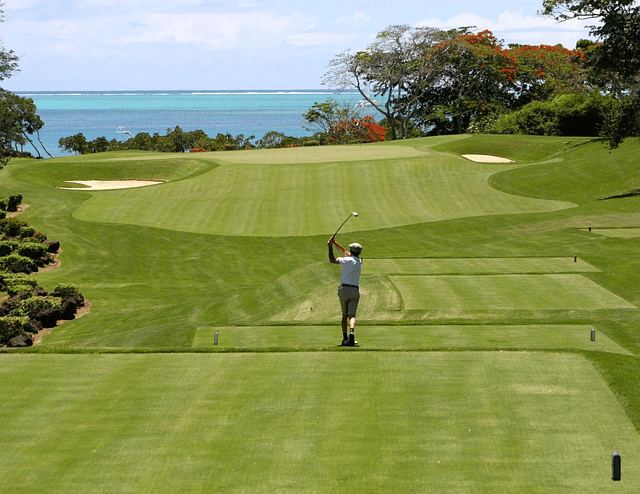I have provided you with a “story” format, using some of the most common golf terminologies in the same context you would normally hear them. There are so many “odd” golf terms players have adopted over the years. Some slang, and some relevant to specific rules.
Then I have defined each of those terms and provided some helpful tips on common courtesies to help you navigate a round of golf.
Quick Navigation
Phrases you’ll hear when you are getting ready to golf.
I booked us a tee time for 9 am, I’ll meet you at the bag drop. We can head into the clubhouse to pay our green fees.
Tee Time
Not what they do in England…Well, they do golf in England. But this refers to the time you start your golf round. You’ll need to be completely ready to take your first swing. You’ll need to arrive about 15 minutes before your tee time to give yourself adequate time to be ready.
Bag Drop
Every course is different, but they typically have an area where players can drop off their golf bags near the clubhouse. Some people stop their cars, drop their bags in the designated area, then go park. Keeps you from having to carry a heavy golf bag through the parking lot.
Clubhouse
This one is pretty simple, but it’s usually the main building at a golf course. Most will have a pro shop where you can get golf balls, tees, shirts, clubs, shoes, etc. Most will also have a bar and restaurant as well.
Geen Fees
The base fee you’ll pay for the round. Typically you can either play 18 holes or 9. If you want a cart, there is usually an extra fee for that. If you are going to walk, they will usually supply a pull cart. Sometimes they are free to use, but some courses may charge a dollar or two.
Alright, we have our cart, Let’s head over to the practice green. Then we can go see the starter at the caddie shack.
Practice Green
This one is pretty self-explanatory, but here are some things to keep in mind when using it. Some courses will have two practice greens for players. One is for putting only, and maybe very short chip shots. The 2nd is for chipping. When chipping, the ball will oftentimes leave a small divot or “dent” in the green. Nobody wants to practice putting on a green full of divots.
Each practice green, or “putting green” will typically have a few holes or flags. Don’t putt at a hole another player is already using. If all holes are being used, you can pick a target on the green elsewhere. It doesn’t need to be a hole. It could be a brown spot on the green, or anything really that gives you a target.
Starter
Sometimes referred to as a marshal, there is a subtle difference, however. A starter is responsible for ensuring golfers tee off on time. They will also pair up smaller groups where necessary. Think of this person as the teenage kid at the amusement park who ushers people onto the roller coaster. They try to fill every seat. Usually, it’s an older man at the golf course.
A marshal is responsible for ensuring players are following course regulations and keeping the pace of play at a normal level. They are the ones kicking out idiots who tip golf carts over.
Caddie Shack
The place Bill Murray hangs out! Most golf courses do not have caddies, but many will have a smaller building where you can get some drinks, get your cart key, some range balls, etc. Think of it as a scaled-down version of the clubhouse.
When a golf course does offer a caddie, this is where you’ll find them. Otherwise, that small building away from the main clubhouse is the caddie shack.
Terms used to describe the Golf Course
Alright, the starter has given us the green light to tee off. We can head onto the tee box, I’ll hit first. Unfortunately, I typically miss the fairway and end up in the rough.
Tee box
This is the area where you start, each hole will have one. It’s usually elevated and sort of rectangular in shape. There will be color-coded markers indicating the start location for players of various skill levels.

Players commonly refer to these start locations by gender and age. For example, the “ladies tees” are marked with red. The “senior tees” are marked with gold. In reality, you should play the level of tee that corresponds to your skill level and the distance you can hit the ball.
When you start a round, pick a tee color and play that color the entire round. The tees are typically arranged as follows from shortest distance to longest distance. Gold, Red, White, Blue, Black. Sometimes you’ll see less, sometimes more, it really depends on how long the golf course is.
Amateur men typically play the white tees, while amateur women play the red tees.
Fairway
The fairway is that area in the middle with the low cut grass, its where you want your ball to end up off the tee.

Rough
The rough is the area just outside of the fairway, the grass is a bit taller and more difficult to hit the ball from. Every golf course is a bit different, some will have rough that is really rough…I mean, tall. Other golf courses will have rough that is basically as tall as your lawn.
Now that we’ve hit our tee shots, it’s time to hit our approach shot. I’m going to try to carry the bunker and land it on the green.
Approach shot
An approach shot is the golf shot that can reach the green. After you hit the ball off the tee, you might be left with between 50 – 150 yards for example. That 50 or 150 yard shot would be called your approach shot.
Carry
Carry is the distance your golf ball travels in the air. Normally, your golf ball will travel further than your carry distance, which would simply be referred to as total distance. Once you get used to your game, you’ll gain an understanding of how far you can hit each club. Knowing your “carry” distance is helpful if you are hitting over a water hazard for example.

I have put together a calculator that will estimate your golf club distances that you may find helpful.
Bunker
A bunker, or sand trap, is a section on the golf course that is full of sand. It is much more difficult to hit out of and should be avoided. At some point, you’ll find yourself “on the beach”, or “in the sand”, or “in the bunker”.
A “Fried Egg” is when your ball gets partially buried in the sand. Lets say you hit a high shot and it lands firmly in the sand, and manages to somehow bury half of the ball. It is a really difficult shot to hit, but somehow looks like a fried egg.
Green
You probably already know what this is…but. The green is the area on the golf course with the shortest grass. This is where the flag is and where you finish every hole.
Ok, so we’ve hit our approach shots. I ended up on the fringe and you hit a great shot close to the pin.
Fringe
The fringe is an area around the green that has slightly higher grass than the green itself, but shorter than the rough. It is also referred to as the “first cut”. Most golfers will putt from the fringe.
Pin
Pin, flag, flag stick. Did you know, the color of the flag, or the height of the “mini flag” on the flag stick indicates where the “pin” is located on the green? Some golf courses have a regular flag, yellow for example. Then, an adjustable “mini flag” that can move up or down the pole.
When that “mini flag” is low on the flag stick, it means the hole location is toward the front of the green. When it is high on the flag stick, it means the hole location is toward the back of the green.
Other golf courses will use colored flags to indicate pin location. Red = Front, white = middle, blue = back for example.
Phrases used when hitting the ball
We’ve finished the first hole and headed to the #2 tee box. I hit a nasty slice that’s headed right for some other golfers. So I yell fore as loud as I can.
Slice
A slice is when your golf ball wildly turns after you’ve hit it, almost like a curve ball. The direction of the curve goes right for a right handed golfer, left for a left handed golfer.
A fade is sort of a mini version of this, usually it is much more controlled and some skilled golfers will try to “fade the ball” on purpose if they need to avoid a bunker or tree for example.
A slice might travel 50 yards offline and usually results in another fairway or in the trees. A fade might only travel 5 – 15 yards offline. Most new golfers will experience this at some point.
Sometimes a golfer may “push” the ball. This isn’t a fade or slice, instead the ball starts out on a path this is “to the right”, for a right handed golfer, and it simply stays on that path. Slice and fade will curve mid-flight.
Fore
A golfer will yell “fore” loudly to warn other golfers that a ball is headed in their direction. If you are on the golf course and you hear someone yell fore, take cover. The direction the yell is coming from is the direction the ball will be coming from. Ducking behind your cart or golf bag is usually best.
If you ever hit a ball in another golfers direction, be sure to give them a warning. Then when you have a chance as you finish out the hole, briefly apologize for your mishit. But don’t feel too bad, this happens all the time and most golfers are reasonable and easy-going about it.
The next person in our group hooks it out of bounds, I think he is going to take a mulligan. The next guy shanks one. Your tee shot is the only one in the fairway and it was a nice shot.
Hook
A hook is when the golf ball wildly turns after you’ve hit it, almost like a curve ball. The direction of the curve goes left for a right-handed golfer, and right for a left-handed golfer.
You’ll also hear a hook referred to as a “duck hook” or “pull hook”. Golfers may also say “I pulled it”, but a pull is really where the ball starts left (for a right-handed golfer) immediately off the tee. The hook is when it curves after its already in the air.
A Draw is similar to a fade, just the opposite direction. A draw is a controlled curve close to the end of your ball flight, moving left for a right-handed golfer and right for a lefty.
Shank
A shank is simply a bad hit causing the ball to shoot off to the right or left, usually not going very far. These happen a lot to new golfers, and quite a bit for experienced amateur golfers. The pro’s even shank one every now and then.
Mulligan
A mulligan is effectively a “do over” on a golf shot. It is not legal from an official scoring perspective, but many amateur golfers will occasionally take a mulligan after hitting a very bad shot. Some groups will have an agreement before a round of golf starts, where they will allow each player to take one mulligan during the round.
As a beginner, mulligans give you the opportunity to gain repetitions on a specific shot, hopefully leading to overall game improvement. As long as you are not holding anyone up, or claiming you had a better score than what you actually had, they are perfectly fine. You cannot use them during competitive play.
Now that those bad shots are out of the way, you hit a great shot from the fairway, taking a nice divot. You’re on the green! I’m struggling a bit and duff my shot.

Divot
Typically when hitting irons, your club will take a chunk out of the grass after making ball contact. This will send a piece of turf flying, called a divot. It is courtesy to pick up your divot and replace it. Just put it back in its spot best you can and push it down with your foot.
Some golf courses will also have a mixture of sand that is in a white canister attached to your cart. Take some of that sand and sprinkle it over your divot mark to help the course repair more quickly and evenly.
Divot is also a term used to describe the “dent” your ball makes when it lands on the green.
Duff
A duff is a bad shot and happens when you hit too far behind the golf ball. The grass will grab your club, slowing it down significantly, usually causing your ball to go a very short distance. Everyone does this at some point, laugh it off and reset for your next shot!
Terms used in golf scoring
It’s a par 4, so you hit the green in regulation. You’ll have a birdie putt, which is amazing! I’m still struggling, looks like I’m looking at a bogey, possibly double bogey.
Par
Par is the expected number of strokes that it should take a skilled golfer to finish a hole. So a par 4, for example, should take you 4 shots to finish.
“Par” is commonly used to describe the sum of all holes as well. So, if you add up “par” on each hole, you may get 72 for all 18 holes (every course is different, but 72 is common).
If you “shoot par” for that 18 hole round, you’ve shot a 72. A golfer may say, “I shot 5 over”, that would mean they had a 77.
Green in regulation
A golfer is typically expected to take 2 shots on the green. So, getting onto the green while still having two more shots before reaching par on the hole, would be considered hitting a green in regulation.
For example, on a par 4 you would need to put your second shot on the green. On a par 3, your first shot would need to be on the green. Par 5, 3rd shot.
Birdie
A birdie is 1 stroke under par. For example, if you are playing a par 4 hole, a birdie would be a score of 3 on that hole. If you are playing a par 5 hole, birdie would be a score of 4 on that hole.
Bogey
A bogey is 1 stroke over par. For example, if you are playing a par 4 hole, a bogey would be a score of 5 on that hole. For an amateur golfer, a bogey is not bad, especially if you are new to golf.
Double Bogey
A double-bogey is 2 strokes over par. For example, if you are playing a par 4 hole, a double bogey would be a score of 6 on that hole.
For more scoring terms, including tournament formats, match play, stroke play, things like that, check out our Golf Scoring Explained post.
At the end of the hole, you count your number of strokes and repeat the process for the rest of the holes! Your final score is typically referred to as “10 over par”, or “15 over par”, or “2 under” at some point in the future after you master this game!
There are a couple more scoring terms that you may hear, but they are pretty rare!
Eagle
An eagle is 2 strokes under par. For example, if you are playing a par 5 hole, an eagle would be a score of 3 on that hole. Eagles are somewhat rare, and good amateur golfers may only get one once every few months or even once a season.
Albatross
An albatross is 3 strokes under par and you need to be playing a par 5 hole for it to be considered an albatross. Otherwise, it would be a hole-in-one. You need to shoot a 2 on a par 5, pretty rare, even for professional golfers. You basically have to put the ball in off of a 200+ yard shot.
Related – Golf Scorecard Explained.
Terminology in Playing Format and General Courtesies
In general, the person who is the furthest out from the hole is up next. However, it is commonly accepted to play “ready golf”. Golf courses will also implement local rules at times to take into account course conditions. They may play winter rules instead of making you play it as it lies.
Ready Golf
When golfing in a group, to assist with speed of play it is common to play ready golf. Ready golf means, if the player who is next up to hit is not quite ready, but another player is, the player who is ready hits.
Although commonly used, it is best not to assume the group you’re playing with adheres to this format. So it is best to follow the typical format of – the player furthest from the hole is next up and you wait patiently. Normally, when that player realizes people are waiting on them, they will tell you to go ahead if you are ready.
You can simply acknowledge that you are good with playing ready golf and move on with the rest of the round.
Winter Rules
Winter rules takes into consideration poor conditions on the golf course that would punish you for an otherwise “good shot”. These modified local rules allow you to move your ball, no closer to the hole, in order to move out of a bad spot caused by local course conditions.
For example, if there is a dead patch of grass in the middle of the fairway and it is dirt. Winter rules would allow you to move your ball back or to the side to the nice turf. You were in the fairway, so it was expected that you would have had a nice surface to hit off of.
This one is kind of like a mulligan in that, it is not to be used in competition.
Play it as it lies
After you hit a golf ball off the tee, you need to play each subsequent shot “as-is”. If you ball comes to rest in a divot that someone did not repair in the fairway, you have to play it from that spot. If it comes to rest against a tree, you need to play it as-is.
This is how the game is supposed to be played, and how it is played in competition. That being said, if you are new and just out to have some fun, don’t risk breaking a club trying to hit a ball pinned against a tree. Move the ball and just have fun.
Gimme
A gimme is when a golfer gives a player a free pick-up. Generally, when the ball is within a couple of feet of the hole, it may be considered a “gimme” because it is very unlikely you’d miss that putt.
Never assume a gimme, wait for a fellow golfer to say something like “pick it up”. Then graciously pick up and count 1 more stroke as if you made the putt.
A general rule of thumb is a gimme needs to be “in the leather”, which means the distance from the bottom of your putter to the bottom of the putter grip.
A gimme can be best defined as an agreement between two golfers, neither of whom can putt very well – Unknown
Scramble
A scramble is where golfers play in teams, each team competing against one another. The most common team size is 4 players. Within your team, each player will tee off. The team captain will choose which of the 4 balls to use. At that point, each player will hit the 2nd shot from that “best ball” location. This process will continue until the ball goes in the hole.
Scrambles can be very fun for beginners. You can go out and hit bad shots and not be “penalized” for it since you’ll have 3 other balls to choose from.
The Four Worst Words in Golf & Funny Golf Sayings
You are still out! This usually means you hit a bad shot and remain the furthest from the hole. It can be very frustrating when you duff a shot, or hit it fat, then follow it up by thinning one over the green.
I have a tip that can take five shots off everyone’s game. It’s called an eraser. – Arnold Palmer
Hit it fat
Hitting behind the golf ball and catching too much grass or ground before making contact with the ball is referred to as hitting it fat. It usually results in a much shorter distance than you wanted.
Hit it thin
Hitting it thin refers to catching the ball with the blade edge of your iron. This causes the ball flight to be very low and it typically goes much further than you planned.
Worm Burner
Worm burner is when you hit a very low golf shot, the ball stays on the ground or very close to it as it speeds down the fairway.
They call it golf because the other four-letter words were taken. – Ray Floyd
Foot Wedge
A foot wedge means you moved your ball with your foot. Usually this is associated with cheating, but if you are just out there having fun and nobody is betting or playing competitively, just have fun!
Snowman
Getting an 8 on your scorecard may be referred to as a snowman.
A general rule of thumb for speed of play purposes, is to pick up once you reach double par. So if it is a par 4 and you’ve hit the ball 8 times, just move on to the next hole. You would not do this in competitive play, and feel free to continue playing the hole if you are not holding up a golfer behind you.
Hosel Rocket
A hosel rocket is a bad shot, a shank, that you hit off the heel of the club head. Where the shaft meets the golf club head is the “hosel”. Hitting one off your club in that location usually results in a shot with good speed, but terrible direction and trajectory.
If you get caught on the course during a storm and are afraid of lightning, hold up your one-iron; even god cannot hit a one-iron. – Lee Trevino
Check out this post for a full list of famous golf quotes!
Good luck on the golf course!
